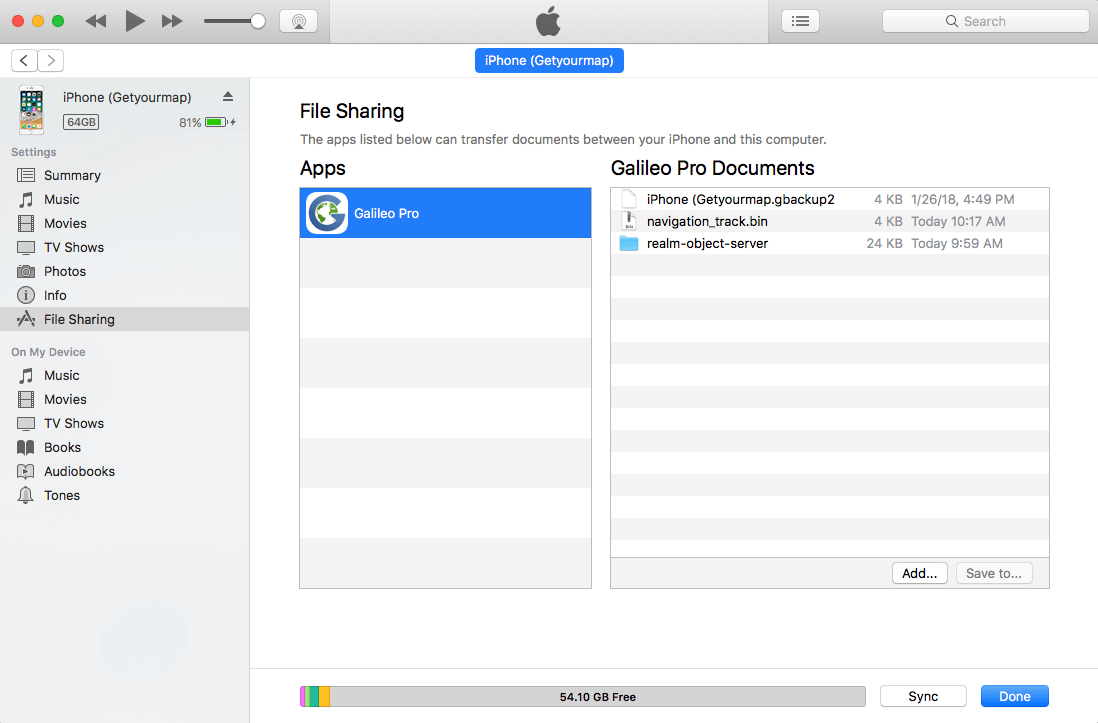Tips, Tricks, and Troubleshooting
This section covers advanced features related to specific areas of the app.
Troubleshooting
Sometimes you may see empty map areas (tiles) with the following warning messages:
- "Tile loading error. Please check your Internet connection" – tiles are missing in the cache and the app cannot download them. Enable an internet connection or switch to online mode to load the missing tiles.
- "Tile loading error. Wrong response from the server" – the online server is not responding. Try viewing this area later to reload the missing tiles.
Offline Maps Import
An in-app purchase allows you to import previously created custom offline maps in .sqlitedb or .mbtiles format.
Creating an offline map
Create an offline map for the desired area in advance using one of the following tools on your computer:
- Mobile Atlas Creator (known also as MOBAC)
- TileMill
- SAS.Planet
Mobile Atlas Creator (MOBAC) – free software that lets you download maps from numerous sources and save them in the .sqlitedb format used by Guru Maps. This tool is compatible with Windows, macOS, and Linux.
Reference: Learn how to create offline maps in .sqlitedb format in the MOBAC manual.
TileMill (by MapBox) – a desktop application for cartographers to design and create offline maps in the .mbtiles format supported by Guru Maps. It is compatible with macOS, Windows, and Ubuntu.
Reference: Learn how to create offline maps in .mbtiles format in the TileMill manual.
SAS.Planet – a program for viewing and downloading high-resolution satellite imagery and conventional maps in .sqlitedb format. Reference: Learn how to create offline maps in .sqlitedb format in the SAS.Planet manual.
Importing offline maps
Once you have created an offline map, upload it to your device. You can import an offline map via iTunes or a cloud service.
Importing using iTunes
Connect your device to your computer and perform these steps:
- Launch the iTunes application and select your device.
- Open File Sharing in the left sidebar and select Guru in the Apps list.
- Add the offline map file to Guru Documents.

Importing from the Files app
In addition to iTunes sync, there is another handy way to upload your offline maps using the iOS Files app:
- Place the offline map file in
.sqlitedbor.mbtilesformat into Files/iCloud Drive on your computer. - Open the Files app on your iOS device and wait until the file syncs automatically.
- Select the offline map, tap the share icon, then choose "Copy to Guru Maps" to start the import.
Using offline maps
Go to Map Source in the app settings, select the imported map, and return to the map view. If you are outside the map area, tap the green arrow that points toward the offline map. Zoom in to see the detailed view.
Getting Exported Files
To access an exported collection, bookmark, or GPS track using File Sharing:
- Launch the iTunes application and select your device.
- Open File Sharing in the left sidebar and select Guru in the Apps list to view a list of the files exported within the app on your iOS device.
- Select the file you want to copy to your computer from the Documents list and click the "Save to.." button.
- Choose the folder on your computer where you want to copy the file and click Open. The selected files are copied immediately.
Hidden Settings
Hidden settings let you tailor the app's behavior and appearance to your needs. To access them, go to the system Settings, scroll down, and choose Guru. The following additional settings are available for Guru:
- Allow overzoom on map. If enabled, the map can be zoomed closer than the scale allows.
- Allow map rotation. If enabled, the app recognizes the two-finger rotation gesture.
- Cluster bookmarks. If enabled, the app groups bookmarks that are close to each other on the map.
- GPS Activity Type. Set the GPS activity type that matches your use case. To read more about the options, follow this link: Activity Types.
- Write GPS log. Enable to log all received GPS coordinates for debugging during development.